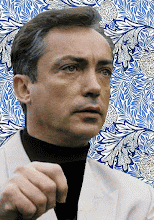Lexicon Devil

Lexicon Devil is a biography about seminal L.A. punk Darby Crash and his band the Germs. The book was written and compiled by Brendan Mullen who had previously collaborated on We Got the Neutron Bomb with Marc Spitz, and support from Don Bolles and Adam Parfrey. For this annotation I am interested in exploring how the authors chose to structure the biography as an oral history that compiles primary source accounts, as opposed to forging an authoritative official story of the period. It reads like a documentary film intercutting elements from many sources to explore a subject. This format is true to the splintered and many voiced nature of the topic and time. It presents the material as alive and open for debate. The primary sources frequently disagree, but one version of the story isn’t necessarily privileged above another. Punk was antiauthority and this structure highlights the “do it yourself” ethic where anyone could grow up to not play their instruments and become a famous rock star in the process. The structure of this work is rigorously pluralistic, a form that highlights the ideals of the subject matter, while serving as a transcript of events surrounding the formation of L.A. punk and its eventual decay and collapse.
The choice to organize Lexicon Devil as an oral history, instead of synthesizing interviews from over two hundred people who were involved in some capacity into a monolithic official story, adds depth while staying true to the source material. The collection is a text to be mined. The book explores the subject as an overlapping network of lives and personalities that preserves the vibrancy and contradictory nature of the period. The biography is structured around shared experience points.
One section, for example, is about West University High in West Los Angeles (Uni High), which was a public school with an experimental program based around Scientology. Many of the early scene types went to school there including Darby Crash. In this section, the early players for the story weigh in with insights and anecdotes about Darby Crash and the original circle one. In this context much of Crash’s ideas can be seen as a response to Scientology (IPS Innovative Program School) and the dieing psychedelic movement in Southern California. Discussing the school’s structure Paul Roessler of the punk band the Screamers stated, “…that was a big Scientology thing, too. I think that was the origin of Darby’s lexicon obsession… The Scientology dictionary thing was probably a major influence in developing his fascination with wordsmithing, word sculpting…” (15). In this context Darby Crash’s persona can be seen as a merging of his fascination with Scientology, LSD culture, and his obsession with glitter rock personalities like David Bowie and Iggy Pop. Gerber, an early L.A. scene type recollects meeting Darby Crash (then Paul Beahm) at a Taco Bell during this period. “He had a red Bowie haircut, a Bowie belt buckle, a Bowie T-shirt, and some kind of emblem painted on his forehead, the thing off the Pin-ups cover. I considered myself totally Bowie freakazoid, but this guy looked like he was Bowie!” (38). The structure highlights how various characters met, interacted, and were influenced by the burgeoning scene congealing around them.
One element that appealed to me while considering this biography was to imagine the whole thing as a work of fiction, because it is essentially about fiction on some level. Paul Beahm became Bobby Pyn (pronounce Bobby Pin) who evolved into Darby Crash. New bands meant new personas. Lexicon Devil is populated with characters with names like Dottie Danger (Belinda Carlisle), Jane Drano (Jane Wiedlin), Casey Cola, and Hellin Killer. These characters constructed themselves and performed their lives in real life, but were also completely made-up and constructed at the same time. The facts may correspond to actual events and real people, but the stories and myths were constructed as they lived them. This highlights the fictive nature of these stories and performance as life. They were creating themselves for the world to see. One comes away with the realization that these lives could just as easily be considered a work of fiction, as they were to be individual real life stories. Their constructed identities were an every day performance blurring the line between art and life, a nihilistic work in progress.
Through these anecdotes, Lexicon Devil explores the process through which the kids who discovered glitter rock after its pull date become the architects of first wave LA punk. This book isn’t so much a portrait of Darby Crash, as it is a portrait of a time and place, a group of people, an ideal, and a way of approaching the world where queer kids and white trash rubbed elbows while creating a new world for themselves; one where they were the celebrities and larger than life personalities they always admired. It is the story of a scene from the early naïve idealism through the arc of an environment in decay with lives destroyed by drug addiction and outside pressures that came with new generations that didn’t understand the original impetus of the small knit group. As John Doe of the band X lamented after a show shortly before Crash’s death by overdose, “…we didn’t know everyone in the audience anymore. The club was filled with those strange characters you’d see in Decline, who weren’t in it for the art, but because they were damaged people who felt like this music was speaking to them” (247). The structure of Lexicon Devil highlights the way the story of Darby Crash and the Germs was actually an overlapping of many lives and stories that inhabited a shared time and space in culture, through the immediacy of first hand accounts.
Labels: annotations, art, darby


0 Comments:
Post a Comment
Subscribe to Post Comments [Atom]
<< Home